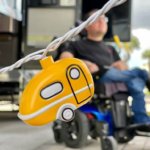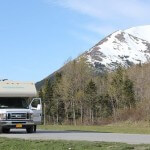Road trips are quickly becoming a main mode of transportation for vacationers and travelers alike, especially during this pandemic. Road trips are a great option because you spend time in your own vehicle, or a rented vehicle, traveling from home to a new destination, exploring the landscape along the way. As a wheelchair user, you can have a very successful and enjoyable road trip, and these 7 tips will help you make the most of your travels.
1: Plan for extra time
Anytime you travel, it’s pretty much a fact that things will take longer than you thought. With road trips, that can mean that traffic, weather, or sleeping in will change how long your trip takes. Given the current pandemic, it’s important to build extra time into your schedule when planning your trip. This time will be useful once you’re on the road, as you’ll probably need to make stops for the bathroom or to eat, and will want an opportunity to get out of the vehicle and take a break from the road.
There’s nothing worse than going on a road trip and having to push that first day to make it to your destination, whether that’s finishing the trip or making it to your first overnight stop. The best way to plan for extra time is consider how long it will take to get to your evening destination and consider what an extra hour or two will do for your time on the road. Meals and breaks can add up quickly and pushing through an extra two hours to reach your destination can transform a fun start into a grumpy ending. Often, choosing to drive for upwards of 8 hours, as opposed to pushing a full 12+, will give you more time for breaks and space to enjoy the drive.

2: Strategic restroom stops
Wheelchair accessible restrooms will be a necessity while on the road, depending on the length of your road trip. Knowing that there will be a place where you can stop, get out of the car, and be able to access the facilities easily gives you more opportunity to enjoy the trip. Depending on where in the United States you’re traveling, many toll roads will have designated rest stops, which are usually wheelchair accessible. Some rest stops will have companion care restrooms as well. These stops also offer food, beverages, and souvenirs, which makes them a good place to stop to take a break and get a bathroom break in.
Another great option for wheelchair accessible restrooms is any Starbucks location. Starbucks, especially the newly remodeled stores, offer a family style companion care restroom. This will make it easy for everyone to make the stop, as Starbucks offers beverages and snacks, as well as a friendly place to take a break. Consider looking for Starbucks along your route when you’re planning your trip and you’ll have a great place to take a break.
It’s good to have an idea of how long you’ll be driving during the day and plan to make a few stops. Looking at the route before you leave will give you an idea of where the stops are, as it’s better to know ahead of time that there’s a Starbucks two hours away than trying to find one when you already need to stop.
3: Pack your own food
Bringing meals, snacks, and drinks allows you to be in control of when you stop and will reduce the amount of people you come into contact with while on the road trip. This will also help you reserve stops for restrooms only, as you won’t need to spend any extra time inside ordering food or dining inside. This is important to consider given the pandemic, as many restaurants and even rest stops may have limitations on how many people may enter at one time. Saving your indoor time for bathroom breaks will shorten the time you need to be inside.
Using meal prep containers gives you a dish to eat your meal and snacks from, as opposed to using plastic bags. These containers will keep each meal together and are easy to clean on the road. Having a cooler with drinks, snacks, and meals will guarantee that you’ll have a meal you enjoy while traveling.
4: Consider having an outdoor picnic
This directly ties into the last tip. If you’re going on a longer trip and you’ll need to eat a meal on the way, look up picnic areas before you leave and consider having an outdoor picnic.
You can find a roadside picnic area, or even use the parking lot of your bathroom stop, any place where you can spend some time outside. Many rest stops have grassy areas with a table or two that can function as a picnic space. Depending on where you’re traveling, you may be able to stop at a park or a scenic lookout for a short meal break.
If possible, choose a few different picnic spot possibilities before going, so then you can eat whenever you feel hungry and you won’t have to go to one specific spot. It’s also a good idea to have multiple places in mind, as one stop may be crowded or closed.

5: Research your route before you leave
Mapping the route will help you ensure all of these tips are included in your trip. Using a GPS while on the road is a good way to stay on track, but knowing the potential options for restroom breaks, picnic spots, and other places to stop for a break will help you feel prepared and more in control while you’re on the road.
When researching your route, it can be helpful to look for the following items:
● Overall trip length: that is the time and miles between your initial departure point and your final destination. It’s useful to know how far you’re going so you can schedule an oil change or make plans to rent a vehicle if needed.
● Daily trip length: how many miles and hours you plan to cover in your day. This will help you plan for stops, side trips, and scenic spots.
● Rest stops: Either those on a toll road or places you’d like to stop while driving. These can be planned with a mix of miles and time, and personal preference.
● Starbucks or other companion care public restrooms: This can make for a good break as well as a good thing to know in case someone in your party needs to stop more frequently.
● Picnic areas and dining options: Places to stop for a meal or a location that offers dining in case you need to stop.
● Gas stations: It’s always good to know how far apart gas stations may be, especially since in some rural places there can be dozens of miles between service stations.

6: Pack for each day
If you’re going on a multi-day road trip, you can save a lot of time at night by packing a bag or two for each day. This gives you less luggage to bring back and forth to a hotel room or campsite and makes it easy to quickly unpack at the end of the day and repack in the morning to get back on the road. Road trip essentials for each night may include something to sleep in, clothes for the next day, toiletries, medication, and any electronics including the charger.
A day bag may be a good idea to have in the vehicle with you during the day. This is the place you put all your electronics and road trip gear so it’s all in one location. Having everything pre-packed before getting in the car helps you keep everything together and makes it easy to get out during the day with everything packed away safely.
7: Research restrictions within your destination and states along the route
Since you may be traveling across state lines, it’s important to know what the state guidelines and restrictions are during the pandemic. It will be good to know if masks are required and if you are required to quarantine after a 24 hour stay. The restrictions and rules are constantly changing, so it’s important to stay up to date on them when traveling.
Things to look for when researching state restrictions:
● If the states you’ll be traveling through have visitor restrictions. Is there a mandatory quarantine for out of state visitors?
○ What are the guidelines for those not staying for 24 hours?
● What are the mask and distancing guidelines for each state?
It’s best to assume there is a mandatory mask order in place everywhere you go, and to use masks as well as proper hand washing and sanitizing anytime you leave your vehicle. Any guidelines will impact a longer, multi-day road trip as staying at a place overnight may apply to the state’s guidelines.
You should also research any specific motor needs that a state might have. You might need to get temporary insurance, for example, and not having that where necessary could land you in some deep trouble if you are not careful. Fortunately, it has never been easier to find cheap car insurance at short notice, so that shouldn’t be too much of a problem.

With a little extra preparation, your road trip can be completely wheelchair accessible and a great way to embrace your inner traveler. Road trips are a great way to plan a vacation, as the trip itself can be the vacation, not just the destination.
These tips are useful for any road trip but especially useful given the pandemic, which requires a bit more research and preparation. By applying these tips to your next trip, you will definitely be more prepared and ready to enjoy each day and every mile.
.
.








I want you to know you are changing many lives. You are giving wheelchair users hope and their families new hope. Thank you! Glad I found your blog.